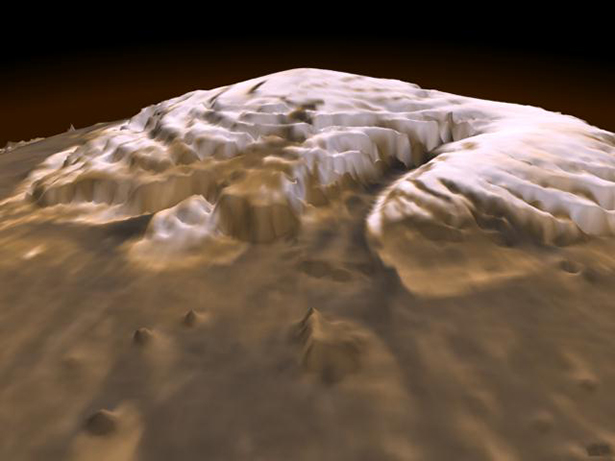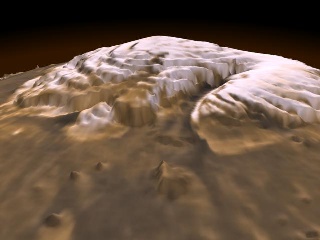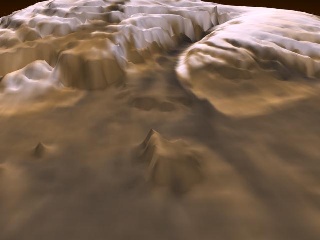 |
National Aeronautics and Space Administration Goddard Space Flight Center |
SEARCH NASA |

 MOLA MOLA |

First Three-Dimensional View of the North Polar Region
of Mars from MOLA
Results Presented at
1998 Fall Meeting of the American Geophysical Union
San Francisco, December 6, 1998
and published in
Science

Douglas Isbell Headquarters, Washington, DC December 6, 1998 (Phone: 202/358-1547) Cynthia M. O'Carroll Goddard Space Flight Center, Greenbelt, MD (Phone: 301/614-5563) Diane Ainsworth Jet Propulsion Laboratory, Pasadena, CA (Phone: 818/354-5011)
RELEASE: 98-219
LASER PROVIDES FIRST 3-D VIEW OF MARS' NORTH POLE
Measurements by a laser altimeter instrument orbiting aboard NASA's Mars Global Surveyor spacecraft are providing striking new views of the north pole of the red planet and the processes that have shaped it.
This first three-dimensional picture of Mars' north pole enables scientists to estimate the volume of its water ice cap with unprecedented precision, and to study its surface variations and the heights of clouds in the region for the first time.
The elevation measurements were collected by the Mars Orbiter Laser Altimeter (MOLA) aboard Global Surveyor during the spring and summer of 1998, as the spacecraft orbited Mars in an interim elliptical orbit. MOLA sends laser pulses toward the planet and measures the precise amount of time before the reflected signals are received back at the instrument. From this data, scientists can infer surface and cloud heights.
Approximately 2.6 million of these laser pulse measurements were assembled into a topographic grid of the north pole with a spatial resolution of .6 miles (one kilometer) and a vertical accuracy of 15-90 feet (5-30 meters). A peer-reviewed paper based on the measurements will be published in the Dec. 11 issue of Science magazine.
The topographic map reveals that the ice cap is about 750 miles (1,200 kilometers) across, with a maximum thickness of 1.8 miles (3 kilometers). The cap is cut by canyons and troughs that plunge to as deep as 0.6 miles (1 kilometer) beneath the surface. "Similar features do not occur on any glacial or polar terrain on Earth," said Dr. Maria Zuber of the Massachusetts Institute of Technology and NASA's Goddard Space Flight Center, Greenbelt, MD. "They appear to be carved by wind and evaporation of ice."
The MOLA data also reveal that large areas of the ice cap are extremely smooth, with elevations that vary by only a few feet over many miles. In some areas the ice cap is surrounded by large mounds of ice, tens of miles across and up to half a mile in height. "These structures appear to be remnants of the cap from a time when it was larger than at present," Zuber said. Impact craters surrounding the cap appear to be filled with ice and dust that was either deposited by wind or condensation, or perhaps remains from an earlier period when the ice cap was larger.
The shape of the polar cap indicates that it is composed primarily of water ice, with a volume of 300,000 cubic miles (1.2 million cubic kilometers). The cap has an average thickness of 0.64 miles (1.03 kilometers) and covers an area 1.5 times the size of Texas. For comparison, the volume of the Martian north polar cap is less than half that of the Greenland ice cap, and about four percent of the Antarctic ice sheet.
The estimated volume of the north ice cap is about 10 times less than the minimum volume of an ancient ocean that some scientists believe once existed on Mars. If a large body of water once existed on the red planet, the remainder of the water must presently be stored below the surface and in the much smaller south polar cap, or have been lost to space. But such a large amount of unaccounted-for water is not easily explained by current models of Martian evolution.
During its mapping of the north polar cap, the MOLA instrument also made the first direct measurement of cloud heights on the red planet. Reflections from the atmosphere were obtained at altitudes from just above the surface to more than nine miles (approximately 15 kilometers) on about 80 percent of the laser profiles. Most clouds were observed at high latitudes, at the boundary of the ice cap and surrounding terrain.
Clouds observed over the polar cap are likely composed of carbon dioxide that condenses out of the atmosphere during northern hemisphere winter. Many clouds exhibit dynamic structure probably caused by winds interacting with surface topography, much as occurs on Earth when winds collide with mountains to produce turbulence.
The principal investigator for MOLA is Dr. David E. Smith of Goddard. The MOLA instrument was designed and built by the Laser Remote Sensing Branch of Laboratory for Terrestrial Physics at Goddard. The Mars Global Surveyor Mission is managed by NASA's Jet Propulsion Laboratory, Pasadena, CA, for the NASA Office of Space Science.
Further information about MOLA and images created from its measurements of the north pole are available on the Internet at the following address: //attic.gsfc.nasa.gov/MOLA/mola.php
Images of the north pole from the Mars Orbiter Camera (MOC) aboard Mars Global Surveyor can be viewed at: //www.msss.com/mars/global_surveyor/camera/images/MENUS/poles_list.html
-end-


